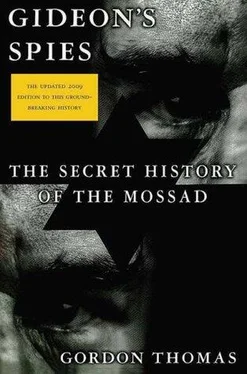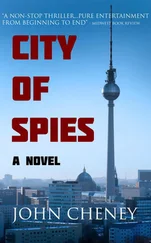“If we let our people die, it will open the floodgates. No Jew will be safe anywhere. Hitler would have won a victory from the grave!”
“Very well,” Rabin had finally said. “We try.”
As well as Kimche, every other strategist and planner in Mossad was mobilized. The first step was to open a safe communication channel between Tel Aviv and Nairobi; Hofi had nursed the unpublicized intelligence link between Mossad and its Kenyan counterpart introduced by Meir Amit. The link started to bear immediate results. Half a dozen katsas descended on Nairobi and were installed in a Kenyan intelligence service safe house. They would form the bridgehead for the main assault. Meantime Kimche had overcome another problem. Any rescue mission would require a fuel stop at Nairobi. Working the phone, he obtained Kenya’s approval in a matter of hours, granted “on humanitarian grounds.”
But there was still the formidable problem of reaching Entebbe. The PLO had established the airport as their own entry point to Uganda, from where the Organization ran its own operation against the pro-Israeli white supremacist regime in South Africa. Idi Amin, Uganda’s despotic dictator, had actually given the PLO the residence of the Israeli ambassador as a headquarters after breaking off diplomatic relations with Jerusalem in 1972.
Kimche knew it was essential to know if the PLO were still in the country. Their battle-hardened guerrillas would be a formidable force to overcome in the short time allowed for the actual rescue mission : the Israeli forces could only be on the ground for minutes, otherwise they ran the risk of a powerful counterattack. Kimche sent two katsas from Nairobi by boat across Lake Victoria. They landed near Entebbe and found the PLO headquarters deserted; the Palestinians had recently moved on to Angola.
Then, with the stroke of luck any operation needs, one of the Kenyan security officers who had accompanied the katsas discovered that one of his wife’s relatives was actually one of the men guarding the hostages. The Kenyan inveigled himself into the airport and was able to see that the hostages were all alive, but he counted fifteen very tense and nervous guards. The information was radioed to Tel Aviv.
Meanwhile, two other katsas, both qualified pilots, hired a Cessna and flew from Nairobi, ostensibly to photograph Lake Victoria for a holiday brochure. Their aircraft passed directly over Entebbe Airport, enabling one katsa to obtain good photographs of the runway and adjoining buildings. The film was flown to Tel Aviv. There, Kimche recommended yet another strategy to confuse the hijackers.
During several telephone conversations with Amin’s palace, Israeli negotiators in Tel Aviv made it clear their government was ready to accept the hijacker’s terms. A diplomat in a European consulate in Uganda was used to add credibility to this apparent surrender by being called “in confidence” to see if he could negotiate suitable wording the hijackers would accept. Kimche told the envoy, “It must be something not too demeaning to Israel but also not too impossible for the hijackers to accept.” The diplomat hurried to the airport with the news and began to draft suitable words. He was still doing so as Operation Thunderball moved to the final stages.
An unmarked Israeli Boeing 707 to be used as a flying hospital landed at Nairobi Airport, flown by IDF pilots who knew Entebbe Airport. Meantime six Mossad katsas had surrounded that airport; each man carried a high-frequency radio and an electronic device that would jam the radar in the control tower. It had never before been tried under combat conditions.
Fifty Israeli paratroopers, under cover of darkness, left the hospital plane and went full speed to Lake Victoria. Inflating their rubber boats, they rowed across the water to wait close to the Ugandan shore, ready to storm into Entebbe Airport. In Tel Aviv, the rescue mission had been rehearsed to perfection; when the time came, a force of C-130 Hercules transporters crossed the Red Sea, headed south, refueled at Nairobi, and then, flying just above the African treetops, swept down on Entebbe Airport.
The radar jammer worked perfectly. The airport authorities were still trying to work out what had happened when the three Hercules transporters and the hospital plane landed. Commandos raced into the building where the hostages were held. By then they were only Jews. All other nationalities had been freed by Amin, enjoying his moment of strutting the world stage. The paratroopers waiting in support were never called into action. They rowed back across the lake and returned to Nairobi. There they would be picked up by another Israeli transporter and flown home.
Within five minutes—two full minutes less than the time allowed—the hostages were free and all the terrorists were killed, along with sixteen Ugandan soldiers guarding the prisoners. The attack force lost one officer, Lieutenant Colonel Yonatan Netanyahu, the elder brother of the future prime minister, Benyamin Netanyahu. He would say that his own hard line against all terrorists came as a result of the death of Yonatan. Three hostages also died.
David Kimche’s wish for a headline-making riposte to hijackers had been more than met. The rescue at Entebbe was an episode that, even more than the capture of Adolf Eichmann, came to be seen as Mossad’s calling card.
Increasingly, Kimche found himself ever more immersed in Mossad’s efforts against the PLO. This deadly struggle was fought beyond the borders of Israel, on the streets of European cities. Kimche was one of the strategists who prepared the ground for Mossad’s own assassins, the kidons. They struck in Paris, Munich, Cyprus, and Athens. For Kimche, the killings were remote; he was like the bomber pilot who does not see where the bombs fall. The deaths helped to foster within Mossad a continuing mood of invincibility: the superior information coming from its strategists meant the kidons were always one step ahead of the enemy.
One morning Kimche arrived at work to find his colleagues in a state of near shock. One of their most experienced katsas had been assassinated in Madrid by a PLO gunman. The assassin had been a contact the katsa was developing in an effort to penetrate the group.
But there was no time to mourn. Every available hand was turned to the task of fighting fire with fire. For Kimche it was a time when “we did not expect to be shown any mercy and showed none in return.”
The relentless pressure continued to find new ways to get close to the PLO leadership and discover enough about its inner workings to assassinate its leaders. For Kimche, “cutting off the head was the only way to stop the tail wagging.” Yasser Arafat was the first head on the kidon target list.
Another and more serious threat had begun to focus Kimche’s mind: the possibility of a second full-scale Arab war, led by Egypt, against Israel. But Mossad was a lone voice within the Israeli intelligence community. Kimche’s concerns, echoed by his superiors, were flatly rejected by Aman, military intelligence. Its strategists pointed out that Egypt had just expelled its twenty thousand Soviet military advisers, which should be interpreted as a clear-cut indication that Egypt’s president, Anwar Sadat, was looking for a political solution in the Middle East.
Kimche remained unconvinced. From all the information crossing his desk, he grew more certain that Sadat would launch a preemptive strike—simply because Arab demands would be impossible for Israel to accept: Egypt wanted back conquered land and the creation of a Palestinian homeland within Israel. Kimche believed that even if these concessions were granted, the PLO would still continue its murderous campaign to drive Israel to its knees.
Читать дальше












